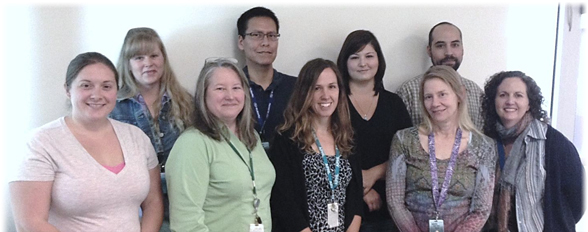Molecular Biology Section
As part of the Biological Services Bureau (BSB), our responsibilities are:
- To serve as a centralized facility utilized by other sections within the Bureau, as well as by our partner, the Department of Agriculture’s Veterinary Diagnostic Services, which is located in the same building.
- To provide Pulsed-Field-Gel Electrophoresis (bacterial DNA fingerprinting), and sequencing (viral RNA typing) analyses in support of the New Mexico Department of Health and CDC/PulseNet/CaliciNet for local and national outbreak investigations.
- To perform clinical testing using Molecular Methods for the detection of microorganisms such as Bordetella pertussis (whooping cough), Campylobacter species (food poisoning), Mycobacterium tuberculosis and non-tuberculosis mycobacteria, Dengue, and Chikungunya viruses.
- To develop, validate, and implement Advanced Molecular Detection methods to increase the overall testing capabilities of the laboratory.
- To perform rapid Molecular Methods to detect bioterrorism threat agents in human, animal, environmental (soil, water, “white powder”), and food samples in response to epidemiologist or law enforcement requests.




Recent Activity
Publications
Latest
- Pulse-field Gel Electrophoresis (Help)
- Sanger Sequencing (Help)
- Real-Time Polymerase Chain Reaction (Help)
Popular
- Instructions for Bordetella pertussis Samples (Help)
- Pyrosequencing (Help)
- Matrix-Assisted Laser Desorption Ionization - Time of Flight (Help)
Resources
Latest
Popular
Our Section
Molecular Methods
These are some of the methods we use.
Pulse-field Gel Electrophoresis
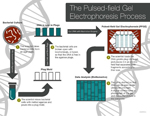 Pulse-field Gel Electrophoresis (PFGE) is the separation of enzyme-digested genomic DNA to generate an organism fingerprint, which is compared to local and national databases to identify strain information and identify potential outbreak clusters.
Pulse-field Gel Electrophoresis (PFGE) is the separation of enzyme-digested genomic DNA to generate an organism fingerprint, which is compared to local and national databases to identify strain information and identify potential outbreak clusters.
Please watch the ScienceLearn PFGE Video to learn more about this method.
Sanger Sequencing
 Sanger Sequencing is the identification of bacterial and fungal organisms by ‘reading’ the DNA letter code and searching against a database library.
Sanger Sequencing is the identification of bacterial and fungal organisms by ‘reading’ the DNA letter code and searching against a database library.
Real-Time Polymerase Chain Reaction
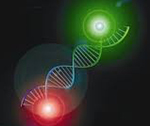 Real-Time Polymerase Chain Reaction (PCR) The targeting of specific DNA sequences of an organism using short primers and a labeled probe to find matching sequences in a sample and track the amplification of those matching sequences during each round of amplification by measuring the fluorescence of the probe. Results are usually expressed as ‘detected’ or ‘not detected’ but can also be expressed as a quantitative value if compared to a standard curve of known values.
Real-Time Polymerase Chain Reaction (PCR) The targeting of specific DNA sequences of an organism using short primers and a labeled probe to find matching sequences in a sample and track the amplification of those matching sequences during each round of amplification by measuring the fluorescence of the probe. Results are usually expressed as ‘detected’ or ‘not detected’ but can also be expressed as a quantitative value if compared to a standard curve of known values.
Please watch the Bio-Rad Real-Time PCR Video to learn more about this method.
Matrix-Assisted Laser Desorption Ionization - Time of Flight
 Matrix-Assisted Laser Desorption Ionization - Time of Flight (MALDI-TOF) is the method where pure, isolated organisms are placed on a specialized plate and vaporized with a laser. The laser causes proteins to disperse and pass through a vacuum tube to a detector within the instrument. Organism identification is made based on the time of flight of the various proteins.
Matrix-Assisted Laser Desorption Ionization - Time of Flight (MALDI-TOF) is the method where pure, isolated organisms are placed on a specialized plate and vaporized with a laser. The laser causes proteins to disperse and pass through a vacuum tube to a detector within the instrument. Organism identification is made based on the time of flight of the various proteins.
Pyrosequencing
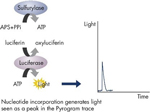 Pyrosequencing is the method where a short, single strand of DNA is sequenced as its complementary strand is synthesized. The release of pyrophosphates, which occurs during the addition of each base, begins a 3-step reaction which causes visible light to be released. The emitted light is detected and analyzed by the instrument.
Pyrosequencing is the method where a short, single strand of DNA is sequenced as its complementary strand is synthesized. The release of pyrophosphates, which occurs during the addition of each base, begins a 3-step reaction which causes visible light to be released. The emitted light is detected and analyzed by the instrument.
Please watch the DNA Tube Pyrosequencing Video to learn more about this method.
Laboratory Response Network
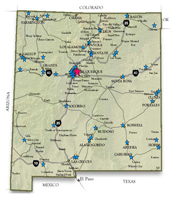 Molecular Biology Section staff are approved by the Centers for Disease Control and Prevention (CDC) to conduct select agent testing as part of the national Laboratory Response Network (LRN). The LRN program supports state public health laboratories in the area of Public Health Emergency Preparedness. The LRN provides standardized testing methods and equipment to state public health laboratories across the United States.
Molecular Biology Section staff are approved by the Centers for Disease Control and Prevention (CDC) to conduct select agent testing as part of the national Laboratory Response Network (LRN). The LRN program supports state public health laboratories in the area of Public Health Emergency Preparedness. The LRN provides standardized testing methods and equipment to state public health laboratories across the United States.
Working in conjunction with state epidemiologists in the Epidemiology & Response Division and local and federal law enforcement, highly-trained analysts are on-call 24 hours a day, 7 days a week to conduct LRN testing.
SLD is the only LRN reference laboratory in New Mexico, and performs rule-out testing for select agents for about 25 sentinel labs across the state.
New Mexico clinical testing laboratories may contact the SLD QSSEP Department for further information on training and testing at 505-383-9006.
Assays Resources
Please visit these CDC resources on assays performed in the molecular biology section.
- CDC Ebola Virus Disease
- Chikungunya
- Dengue
- Anthrax
- Plague
- Enteric Diseases
- Pertussis (Whooping Cough)
National Disease Tracking Databases
These are the national disease tracking databases to which BSB submits data.


